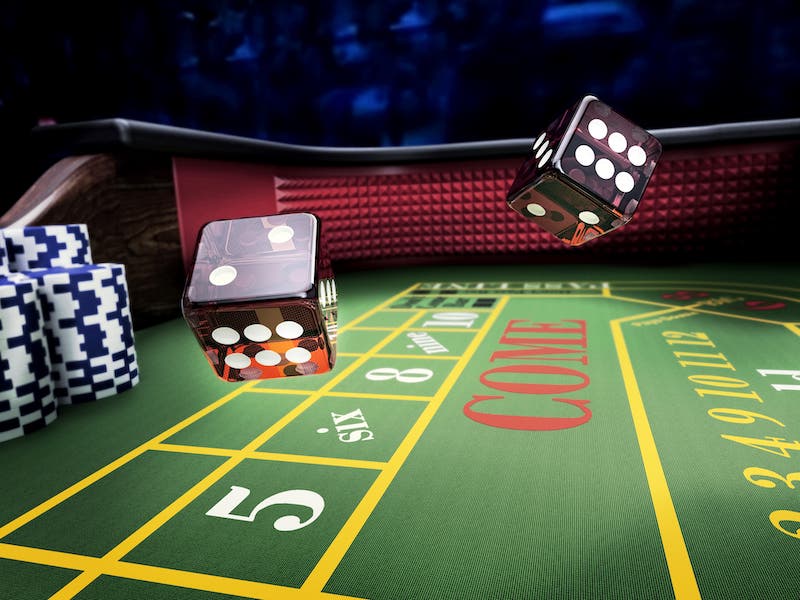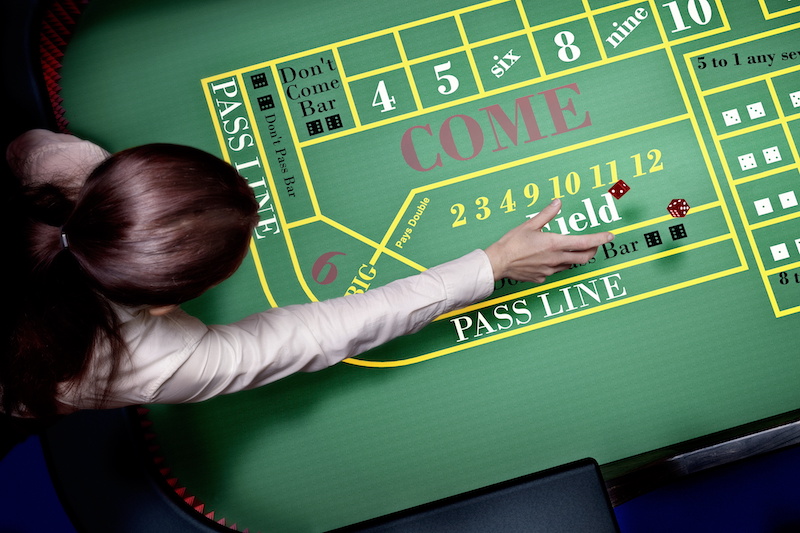Other than 7, the 6 and 8 are the most frequently rolled numbers in craps. And since 7 is a losing number in most craps bets, 6 and 8 are high on the priority list for players. Whether you're looking at place bets, put bets, or the big 6 8 craps options on the layout as part of your craps strategy, it’s important to understand your choices.
There are several ways to have 6 and/or 8 working for you. All are winners if the shooter rolls your number before a 7, but they're not all created equal. Each way has its own strengths and weaknesses.
Place Bets on 6 and 8
Among the better bets in the casino, place bets on 6 or 8 carry a house edge of just 1.52%. You can bet on either number, or you can bet on both at the same time – something that's true of all the ways to bet 6 or 8 listed here.
A place bet on either number wins 45.5% of the time, and winners pay at 7-6 odds provided you bet in multiples of $6. These are among the best odds on 6 and 8 in craps.
When deciding how much to bet on 6 and 8 in craps, you don't want to place $5 on 6, for example, because if you win, the house will pay you just $5. If you bet $6 instead, the house will pay you $7.
How Place Bets Work
Imagine you wager $6 on a place bet on 6. If the shooter rolls a 6, you win. If the shooter rolls a 7, you lose. If the shooter rolls any other number, it doesn't affect the outcome. Your wager stays in action unless you choose to take it down.
That leaves 11 rolls that can decide your bet – the six ways to make 7 and the five ways to make 6.
In a hypothetical sequence of place bets in which each possible outcome happened once, you would lose your $6 six times. Five times, you would keep your $6 bet and get $7 in winnings.
That's a total of $13 on your side of the table for each win, and since there are five winning rolls, you have $65 of your original $66. Divide the $1 on the house side of the table by the $66 in wagers, then multiply by 100 to convert to a percentage, and you get the 1.52% house edge.
Place bets on 8 work the same way – five ways to win, six ways to lose, 7-6 payoffs on winners and a 1.52% house edge.
The house edge isn't quite as low as the 1.41% on pass or come, and you can't back place bets with free odds. But bettors who can't afford free odds like the reasonable house edge while getting the 6 and 8 in play. And some pass-plus-odds bettors will place 6 and/or 8 in addition to the pass bet if a less frequently rolled number is established as the point on the comeout roll.
If this article interests you, keep reading. Alternatively, explore other topics like blackjack strategy and roulette strategy.

Put Bets: A 6/8 Craps Strategy for Bigger Bankrolls
These are pass line bets after there's already been a comeout. You can then bet on pass and take the point that's there.
It's not a bet that's made often, but if the point is 6 or 8, it's an option to get frequently rolled numbers working for you. There's an upside and a downside.
The Downside of Put Bets
Downside first: because this is a pass line bet, it pays only even money, not the 7-6 odds you'd get for placing 6 or 8. And because you've not had your bet down for the comeout roll, you've passed up the portion of the pass bet with eight ways to win and only three ways to lose.
Instead of the normal 1.41% house edge on pass, the edge soars to 9.09% on put bets on 6 or 8.
The Upside: Free Odds on 6 and 8 in Craps
Now the upside: the put bet status as a pass line bet means you can take free odds. For bigger bettors, the overall house edge can be even lower than on the place bets.
The key is that free odds are paid at true odds and have no house edge. For 6 and 8, winning odds bets are paid $6 for every $5 wagered. The overall house edge on the combination is a weighted average of the 9.09% on the put bet and the zero percent on the odds.
There's a breakeven point at 5x odds, meaning your odds bet is five times your put bet. At that point, the house edge on put plus odds is the same as on the place bets.
How Much to Bet on 6 and 8 in Craps with Put Bets
Let's say you bet $5 on the put bet and $25 in odds and get 11 rolls in which each of the decision numbers comes up once.
Your total risk is $330. On the six 7s, you lose the full $30. On each of the five winners, you keep the $30 total wager and are paid $5 for the put bet and $30 for the odds.
At the end of the trial, that leaves $325 on your side of the table. The house profit is $5, or 1.52% of the $330 risked.
If you make free odds bets larger than five times your put bet, the house edge drops even more. In a casino with 10x odds, if you're sufficiently bankrolled to back your put bet with an odds bet 10 times as large, the overall edge plunges to 0.83%.
You can't make put bets on 6 and 8 at any time like you can place bets. You have to wait for a pass-line point to be established as one of your numbers. And if you have a modest bankroll, put bets are not for you. With less than 5x odds, you're better off with place bets.
But for higher rollers, the ability to take free odds makes put bets an advanced 6 and 8 craps strategy that can dramatically slice the house edge.

What is Big 6 and 8 in Craps?
On the corners of most craps layouts are a big numeral 6 right next to a big numeral 8. These craps Big 6 and 8 bets are highly visible but come with a catch.
If you bet in these spaces, you get a wager that works just like place bets on 6 or 8. If the shooter rolls your number, you win. If the shooter rolls a 7, you lose. If the shooter rolls any other number, your bet stays in play unless you choose to take it down.
Why Big 6 Big 8 Craps Bets Should Be Avoided
Problem is, Big 6 and Big 8 pay winners even money instead of the 7-6 you get on the place bets. That leaves a 9.09% house edge.
Big 6 and Big 8 are the equivalent of making the place bets for only $5 instead of $6 and not getting the boosted return. They're the equivalent of put bets on 6 or 8 without the free odds.
In short, they give you the worst of the other ways to bet 6 and 8 without giving you the best.
Final Recommendations for 6-8 Craps Strategy
When it comes to 6 and 8 craps strategy, bettors who want to specify these numbers should choose place bets if they're not going to take free odds.
They should consider put bets when the established point is 6 or 8 if they are sufficiently bankrolled to back their bets with at least 5x odds.
The time to bet on Big 6 or Big 8? Never. Use one of the other options instead.


